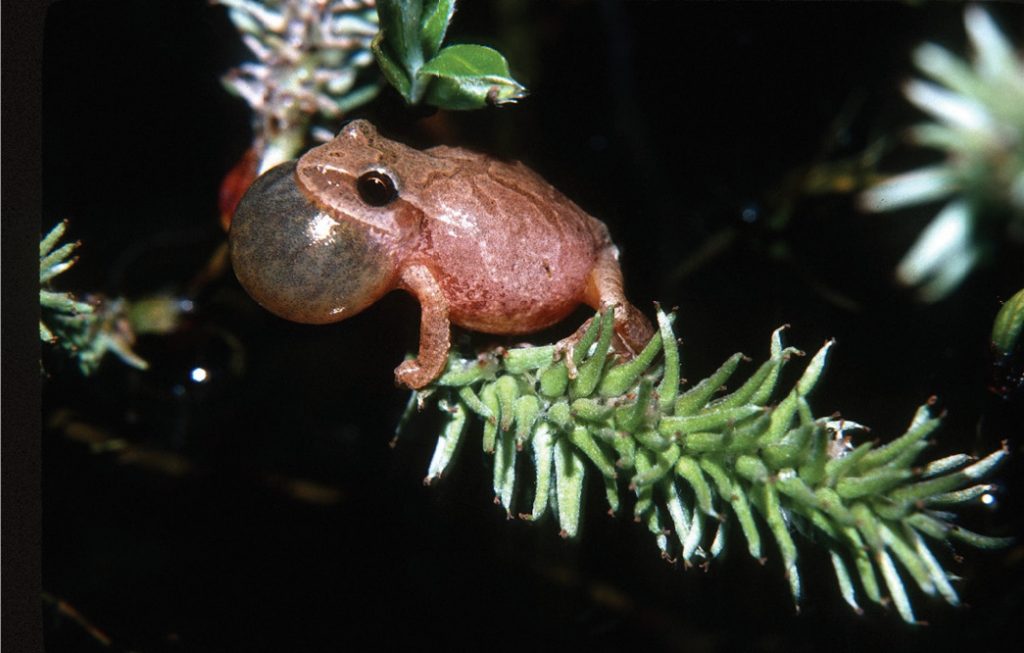By Betsy Painter
Soaring along the water, one of the wonders sailors are privy to is how the coastline alters with each habitat, like a gradient of landscapes shifting from sandy beaches to rocky shores, then grassy meadows. These coastal meadows are wetlands—habitats where land and water mix and merge, fluctuating with the rain and tides. Coastal wetlands help keep the very water we sail through healthy by filtering out pollutants and trash, and acting as a nursery for birds, fish, and crustaceans.

Spring peeper, Long Island © Bob McGrath, Adjunct Professor, Department of Sustainability, SUNY Stony Brook
In wetlands further inland, another wonder of the world exists: the amphibian. Frogs, toads, salamanders, and newts especially depend upon a distinctive type of freshwater wetland called vernal pools. Also called ephemeral wetlands, they appear and disappear with the rain cycle and fluctuating ground water levels, as linked to precipitation as a sailboat is to gusts of wind.
What do amphibians and sailors have in common, you might ask? For one, they both excel on the water and on land. They also both depend on wetlands—although amphibians are likely more acutely aware of this because their life cycles are in tune with the shifting statuses of vernal pools.
Amphibian reproduction is synced with these transient ponds; their arrival early each year (vernal means “spring”) creates an ideal nursery for tadpoles. The mole salamanders (including the Eastern tiger salamander) begin reproduction when rain melts the ice over vernal pools. They emerge from their subterranean tunnels, cross the snow and ice, and slip down into the pools to begin breeding.
Most amphibians begin their lives as tadpoles with gills, gradually morphing into four-legged adults equipped with lungs. Some skip the lung-creating step and breathe through their permeable skin. These unusual adaptive feats allow amphibians to survive the demands of both terrestrial and aquatic realms.
Adapting to the slow and steady rhythms of the natural world, however, is different than adapting to the often dramatic and fast-paced changes in the human-built environment. Unfortunately, the wetland habitats many amphibians rely on are often targeted for dredging, draining, and filling during development projects.
Recently, amphibians and their habitats received special attention in New York environmental policy. Over one million more acres of freshwater wetlands and vernal pools will receive protections under new draft regulations released this summer. These steps to bolster state protections come at a critical time, after Supreme Court rulings weakened federal wetland regulations last year.
In southeast Connecticut, wetlands in the 1,000-acre forest known as The Preserve are also in need of greater protection. The Forestry Division of the CT Department of Energy and Environmental Protection (DEEP) is preparing to conduct timber harvesting at The Preserve as part of forest management. At Save the Sound, we have let DEEP know we care about the sustainable management of this priceless forest and its wetlands, emphasizing close monitoring to ensure stringent practices for protecting critical habitats are followed. Pollutants from runoff at work sites, for example, can smother or poison delicate amphibian eggs in vernal pools.
Amphibians’ sensitivity, with their specific reproductive needs and permeable skin, make them ecological indicators—a slicker, wilder “canary in the coal mine.” Considering amphibians in our human activities helps their populations persist in slinking, hiding, hopping, and crawling around wetlands and forests, bridging the worlds of water and land, while alerting us to subtle, important changes in our shared environments.
As our planet becomes more unpredictable with a changing climate, amphibians teach us the importance of cooperating with the natural world. Like a sailor responds to changes in the wind, we can respond and work with the natural cycles of our local ecosystems as we are propelled into a future where we must adapt to extreme weather as the new norm.
Already, the Long Island Sound region is seeing stronger storms and heavier rainfall. Protecting and restoring wetlands is a nature-based solution for preventing storm damage and flooding, as wetlands absorb wave energy and water. Incorporating wetlands in our adaptation and resilience plans has the added benefit of absorbing toxins and excess nutrients from entering waters we cherish for recreation and drinking water. Wetlands can even act as important carbon sinks, slowing climate change.
Rather than prioritizing the stagnant structures of sidewalks, pavement, buildings, and sea walls, which harm ecosystems, we can protect more vernal pools and incorporate wetlands, benefiting from their roles in flood prevention, stormwater management, and water purification. Perhaps working more with the natural patterns of the environment, we will adapt in amphibious ways, more in sync with our dependence on nature.
Save the Sound works across the Long Island Sound region to protect the Sound and its rivers, fight climate change, save endangered lands, and work with nature to restore ecosystems. More info at savethesound.org. ■




